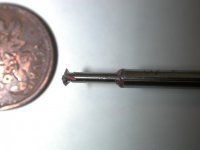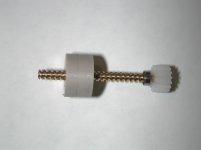The purpose of the tap I am trying to make is to cut threads into aluminum 6061 plates. I don't need a precise fit. The tool steel I have is W1 steel. The thread I need to make has about a 0.56" major diameter a 0.36" minor diameter a pitch of 6 and a flat at the bottom of roughly .050" . The particularly odd part of this thread is that it has a tooth angle of 32 degrees. I ground a HSS square bar to the 32 degree form and put a flat on the nose to just slightly narrower then the male thread. I set my top slide to slightly under 16 degrees and used a live center for support. I was using a 5C collet to hold the stock in the headstock. I started with increments of about 0.0025" depth of cut with a spring pass about every three cuts but by the time I was at about a total depth of 0.025 I noticed the stock was sliding back in the collet. So I changed to a 5C to ER32 collet adapter and added a stop to help keep the part from sliding. I continued turning and by the time I was at 0.040" depth I changed to 0.001" depth of cut. When I got to about 0.05" total depth the part rode onto my tool and sheared off.
I attempted to make the tap again but this tine I started with a 60 degree threading tool to remove material first so I made less contact when I changed to the 32 degree threading tool. But I again rode up and broke off, this time at about a 0.07" total depth and still using the 60 degree threading tool.
So at this point I am not sure what change I should make. I have no experience with turning tool steel any tips would be appreciated.
I attempted to make the tap again but this tine I started with a 60 degree threading tool to remove material first so I made less contact when I changed to the 32 degree threading tool. But I again rode up and broke off, this time at about a 0.07" total depth and still using the 60 degree threading tool.
So at this point I am not sure what change I should make. I have no experience with turning tool steel any tips would be appreciated.




 It was #28 or 29, I swear you could swing a two-lane suspension bridge off that thing. First time I've ever passed out in the doctor's office, never again. Gimme Goerge Washingon's wooden ones, I don't care ....
It was #28 or 29, I swear you could swing a two-lane suspension bridge off that thing. First time I've ever passed out in the doctor's office, never again. Gimme Goerge Washingon's wooden ones, I don't care ....